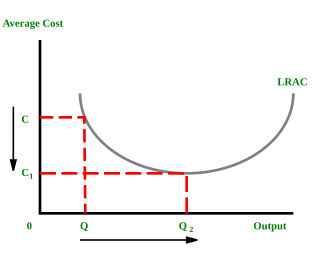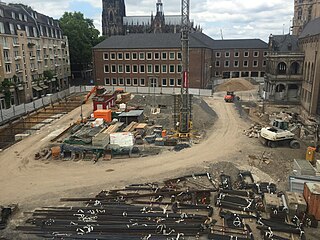Related Research Articles

In microeconomics, economies of scale are the cost advantages that enterprises obtain due to their scale of operation, with cost per unit of output decreasing which causes scale increasing. At the basis of economies of scale there may be technical, statistical, organizational or related factors to the degree of market control.

Construction is a general term meaning the art and science to form objects, systems, or organizations, and comes from Latin constructio and Old French construction. To construct is the verb: the act of building, and the noun is construction: how something is built, the nature of its structure.
Procurement is the process of finding and agreeing to terms, and acquiring goods, services, or works from an external source, often via a tendering or competitive bidding process.

An operating expense, operating expenditure, operational expense, operational expenditure or opex is an ongoing cost for running a product, business, or system. Its counterpart, a capital expenditure (capex), is the cost of developing or providing non-consumable parts for the product or system. For example, the purchase of a photocopier involves capex, and the annual paper, toner, power and maintenance costs represents opex. For larger systems like businesses, opex may also include the cost of workers and facility expenses such as rent and utilities.
Design–bid–build, also known as Design–tendertraditional method or hardbid, is a project delivery method in which the agency or owner contracts with separate entities for the design and construction of a project.
A general contractor, main contractor or prime contractor is responsible for the day-to-day oversight of a construction site, management of vendors and trades, and the communication of information to all involved parties throughout the course of a building project.
A Quantity Surveyor (QS) is a construction industry professional with expert knowledge on construction costs and contracts. Qualified professional quantity surveyors are known as Chartered Surveyors in the UK and Certified Quantity Surveyors in Australia and other countries. In some countries such as Canada, South Africa, Kenya and Mauritius, qualified quantity surveyors are known as Professional Quantity Surveyors, a title protected by law.
Construction management (CM) is a professional service that uses specialized, project management techniques to oversee the planning, design, and construction of a project, from its beginning to its end. The purpose of Construction management is to control a project's time / delivery, cost and quality—sometimes referred to as a project management triangle or "triple constraints." CM is compatible with all project delivery systems, including design-bid-build, design-build, CM At-Risk and Public Private Partnerships. Professional construction managers may be reserved for lengthy, large-scale, high budget undertakings, called capital projects.
Established in 1967, the Architectural Association of Kenya (AAK) is Kenya’s leading Association for professionals in the built and natural environment in Kenya incorporating consultants in the professions of Architecture, Quantity Surveying, Town Planning, Engineering, Landscape Architecture, Environmental Design Consulting and Construction Project Management.
A bill of quantities is a document used in tendering in the construction industry in which materials, parts, and labor are itemized. It also (ideally) details the terms and conditions of the construction or repair contract and itemizes all work to enable a contractor to price the work for which he or she is bidding. The quantities may be measured in number, area, volume, weight or time. Preparing a bill of quantities requires that the design is complete and a specification has been prepared.
A cost estimate is the approximation of the cost of a program, project, or operation. The cost estimate is the product of the cost estimating process. The cost estimate has a single total value and may have identifiable component values.

Construction waste or debris is any kind of debris from the construction process. Different government agencies have clear definitions. For example, the United States Environmental Protection Agency EPA defines construction and demolition materials as “debris generated during the construction, renovation and demolition of buildings, roads, and bridges.”
Construction bidding is the process of submitting a proposal (tender) to undertake, or manage the undertaking of a construction project. The process starts with a cost estimate from blueprints and material take offs.
Cost engineering is "the engineering practice devoted to the management of project cost, involving such activities as estimating, cost control, cost forecasting, investment appraisal and risk analysis." "Cost Engineers budget, plan and monitor investment projects. They seek the optimum balance between cost, quality and time requirements."
Construction cost estimating software is computer software designed for contractors to estimate construction costs for a specific project. A cost estimator will typically use estimating software to estimate their bid price for a project, which will ultimately become part of a resulting construction contract. Some architects, engineers, construction managers, and others may also use cost estimating software to prepare cost estimates for purposes other than bidding.
The New Engineering Contract (NEC), or NEC Engineering and Construction Contract, is a formalised system created by the UK Institution of Civil Engineers that guides the drafting of documents on civil engineering and construction projects for the purpose of obtaining tenders, awarding and administering contracts. As such they legally define the responsibilities and duties of Employers and Contractors in the Works Information. The contract consists of two key parts the Contract Data part one and Contract Data part two. Several approaches are included making it a family of options. It is used in the UK and internationally in countries including New Zealand, Australia, Hong Kong and South Africa.
Edward Skoyles was the first quantity surveyor employed in the UK to research costs and practices in the construction industry. He did his research from 1960 until 1984 at the Building Research Establishment. Among his research projects was developing a new type of tendering for construction projects called operational bills. He also started the study of the actual amount of waste in the construction industry, and investigated the varying methods of cost estimation practices used in different countries. His contributions are still widely discussed in the academic literature particularly upon operational bills, and building waste
The following is a glossary of terms relating to construction cost estimating.
A construction contract is a mutual or legally binding agreement between two parties based on policies and conditions recorded in document form. The two parties involved are one or more property owners and one or more contractors. The owner, often referred to as the 'employer' or the 'client', has full authority to decide what type of contract should be used for a specific development to be constructed and to set out the legally-binding terms and conditions in a contractual agreement. A construction contract is an important document as it outlines the scope of work, risks, duties and legal rights of both the contractor and the owner.
Early contractor involvement (ECI) is a type of construction contract where the principal contractor is engaged at an early stage in a project to offer input into the design phase. It is in contrast to the design–bid–build model where the contractor is only brought onboard at the end of the design phase. The model allows the contractor to have an input in the design of the scheme and suggest value engineering changes. Studies have shown that savings of around 10% in construction phase time and 7% in cost are achievable through the use of ECI. The ECI model has become increasingly popular in the United Kingdom since the early 2000s and is also used in Australia and New Zealand.
References
- 1 2 3 Skoyles, E. R. (1966) Examples from operational bills OCLC 61861509
- 1 2 3 Skoyles, E. R. (1967) Preparation of an operational bill. Building Research Station ISBN 978-0-85125-019-9 OCLC 271085985
- ↑ Shanley LF. (1970). Report on pilot project on operational bills. An Foras Forbartha (Irish National Institute for Physical Planning and Construction Research) ISBN 978-0-9501356-0-1
- ↑ England Symposium on Operational Bills (1967). "Symposium on Operational Bills discussion. Report on a Symposium on Operational Bills held at the Building Research Station, 8th March." ASIN B000X8332G
- 1 2 3 4 5 Potts, K. (2008). Construction Cost Management: Learning from Case Studies, Routledge. ISBN 978-0-415-44286-2
- ↑ Royal Institute of Surveyors (Republic of Ireland Branch) (1970). The bill of quantities and the operational bill: Seminar, Dublin, March. An Foras Forbartha (Irish National Institute for Physical Planning and Construction Research) ISBN 978-0-900115-01-1
- ↑ Skoyles, ER. (1970). Bills of quantities, or the operational bill? Architects' Journal (28 January) 233-240.
- ↑ Skoyles, ER. (1981). Production orientated tendering: a resume and re-examination for the early eighties of the issues involved. Quantity surveyor, 37, (6) 110-113.
- ↑ Skoyles, ER. (1968). Introducing bills of quantities : (Operational format). Building Research Station. OCLC 61864680
- ↑ Skoyles ER. (1969).Examples from bills of quantities (Operational format). Building Research Station. OCLC 43131569
- 1 2 3 4 Ashworth, A. (2002). Pre-contract studies: development economics, tendering and estimating. Edition: 2. Wiley-Blackwell. ISBN 978-0-632-06472-4 p.332.
- ↑ Lal H. (2002). Quantifying and Managing Disruption Claims. Thomas Telford. ISBN 978-0-7277-3165-4.
- 1 2 3 Dmaidi, N. (2003). The State of the Art in Integration of Cost and Time Models Archived 2010-05-29 at the Wayback Machine . An-Najah University Journal of Research. 17(1). 99-122. pp. 108-109
- 1 2 Jaggar D. Ross A. Smith J. Love P. (2002). Building Design Cost Management. Edition: 2. Wiley-Blackwell. ISBN 978-0-632-05805-1 pp147-148